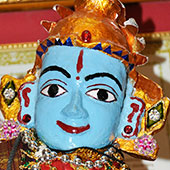Design Resource
Gombe Atta - Agalkote, Karnataka
Puppet Show
by
Prof. Bibhudutta Baral, Divyadarshan C. S., Lija M. G. and Vijay G.
String puppets of Karnataka are usually called as Gombeyatta and are styled, modeled and designed after characters of Yakshagana, the traditional theater form of this region. India has a long tradition of puppetry since it is one of the folk theater arts which have been practiced from ancient time. As per the artisan, Y. K Padhye was the first Ventriloquist of India to introduce the form of puppets in the year 1920. Puppetry is a form of theater or play performed to overcome new ideas of communicating and need of the human society. A puppet is one of the most extraordinary and creative inventions of mankind. Traditional puppetry is a famous folk art in India which spreads the stories and epic of mythology to the people. Puppetry was one of the entertainments given to the people of rural areas.
During the previous centuries the folk theater enjoyed social prominence and it kept the rural audiences entertained and contributed to the growth of the modern theater in different languages. The simplicity and naturalness of folk theater still entertain present society both urban or rural. Children are very receptive to puppetry and by instilling in them a taste for this art, which can mold them into citizens who conserve a fading part of their cultural heritage. Puppets are accompanied by scripts and other musical instruments which have been melodiously blended into folk song and the instruments are played by expert artisan’s team. The puppets have rounded figures with legs, and joints at shoulders, elbows, hips and knees. Five or more strings attached to a puppet figure are tied to a rod-like wooden prop. The “Gombe Atta” is inspired by the “stories based on episodes drawn from epics of Ramayana, Mahabharata and, Puranas”. The highly dramatic music is a blend of folk and classical style. Generally thin strings are used to control movement of light puppets and heavier puppets are controlled with rods for better manipulation, which has no life and made entirely from wood. Earlier puppetry shows helped villagers to convey and popularize social themes on education, environment, savings and entertainment.
There are three different ways to control the puppets which are commonly known as:
1. Suthrada Gombe (puppets handled with threads).
2. Shalake Gombe (puppets handles with rods).
3. Marionette (small puppets).
“Shalake Gombe” or “Traditional rod puppetry” is a third generation family puppeteers started (around 1920) in Agalkote (a small village near Magadi) in Karnataka and re-established in 1983 as “SUTHRMELA” by Shri Narahari Sastry in Bengaluru. Metal rods of diameter 2-3 millimeter are used to manipulate puppets. Height of each character is about 4-5 feet which is highest among other types of puppets. Shalake Gombe is rich in dress and ornaments with characters of god, goddess, king, queen and animals. Team consists of six people for music and dialogue delivery with musical instruments and five people for the puppet manipulation.









